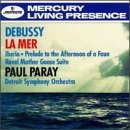| All Artists: Debussy, Paray, Detroit Symphony Orchestra Title: La Mer / Iberia Members Wishing: 0 Total Copies: 0 Label: Polygram Records Release Date: 9/20/1994 Genre: Classical Styles: Ballets & Dances, Ballets, Historical Periods, Modern, 20th, & 21st Century Number of Discs: 1 SwapaCD Credits: 1 UPC: 028943434324 |
Search - Debussy, Paray, Detroit Symphony Orchestra :: La Mer / Iberia
 | Debussy, Paray, Detroit Symphony Orchestra La Mer / Iberia Genre: Classical
|
Larger Image |
CD Details |
CD ReviewsAnother Paray classic you MUST have Mark McCue | Denver, CO USA | 03/31/1999 (5 out of 5 stars) "La Mer and Iberia are heard quite often on concert programs and on record. It's not often that they're done all that well, though.I sat down with this CD and compared it with old Mercury first edition vinyl. Wilma Cozart, director of the original sessions, did a superlative rehab job here. Some of the tubby bass, the tape hiss, and Paray humming along, is gone. And like the Chausson symphony rehab, so is the stereo spread that on LP gives you a real picture of an immense orchestra. But this is beside the point: Paray's classic performances remain in all their treasurable splendor. He was the one conductor who understood that Impressionism had more to do with classically-wrought clarity of expression to develop delicate, pointillistic color than mushy vague outlines and verdigris; this is particularly true in Iberia, and he delivers it with metric pomp, stature, and ethnic color like no other. This Iberia is Basque Iberia, the only Spain Debussy ever visited, and the ethnic heritage of Ravel. We really feel in those highways and byways, and no wonder Falla was impressed with the piece.Paray is also the only recorded maestro to give that gong a really good WHACK in Ma Mere L'Oye; everyone else wimpily taps it...in the score, Ravel specifically directs SFZORZANDO. The percussion overall in this performance is like finely cut crystal on a starched linen cloth, breaking light into a million lustrous colors to scatter across the patina of a silver nappy. Cozart kept a little background noise for us to get all that Paray color into our ears and heads. The balance of the disc is equally treasurable for similar reasons, and the entire production should be in every serious musicologist's/ music-lover's collection, filed at the front of the pack. To understand the French aesthetic, one needs an entrancing class with Paul Paray, the professeur artistique. You'll hear, and you'll immediately understand what makes him and the music so special." Deep sound ben | France | 06/18/2002 (5 out of 5 stars) "I heard many "La Mer" interpretations and i can tell that this one is currently my favourite. This is not the first time that the association of an American orchestra and a French conductor makes great recordings. "Ibéria" is so good here too. And about the sound: it is deep, real, noisy, palpable. Months after buying this record, i learnt how it was recorded. 3 tracks recording in Old Orchestra Hall of Detroit: 2 microphones are used for a transparent stereo, and the third is used to moderate the record between ambiant/direct sound and extend more or less stereo phase between the 2 others by analog substraction. It is ingenious simplicity. This album covers: 1) a must in Debussy's famous orchestral work (and a so delicate Ravel bonus) 2) a must in the interpretation (Detroit/Paray) 3) a must in the sound rendering (Old Ochestra Hall, Detroit)" Paray's La Mer is a must-have Classic Music Lover | Maryland, USA | 01/21/2009 (5 out of 5 stars) "While all of the performances on this CD are very fine, one in particular rises to the top of available interpretations, at least in my view. And that is "La Mer", in a performance that dates from the very earliest days of stereo (1955). It's performed here by Maestro Paray in a way that makes it sound fresh and alive all over again, like when you heard it the first time. When you consider that Paray was born and raised in a seacoast village in Normandy, it's not at all surprising that he has a more innate understanding of this kind of music than the vast majority of other conductors.
I particularly enjoy the second movement of La Mer (Play of the Waves), in which the conductor is lighter and airier than any other performance I've heard on CD or in the concert hall -- pure gossamer. Just listen to the harp glissandi, faster than most -- but how natural and effortless they sound -- hey, just like sea spray! And in the final movement (Dialogue of the Wind & the Sea), Paray delivers us all of the ferocity, while reminding us that we are still out in the water or at the coast. Too many other conductors forget this and instead just blast the music out like Shostakovich or somebody. With Paray, the closing bars of the work are absolutely thrilling -- a climax that's perfectly done. Of the remaining items on the CD, the Faune Prelude is very nicely played -- pretty straightforward, which is refreshing after so many other performances that basically fall apart under a morass of taffy-like stretched out musical phrases, excessive somnolence or just plain lethargy. Personally, I find Paray's interpretation of Iberia a tad too businesslike - especially in the final movement. The Mother Goose Suite is wonderful up until the very final measures, when an over-eager percussion player ruins things by overwhelming the rest of the orchestra with an irritatingly loud suspended cymbal roll. But otherwise, movements in the suite like Beauty & the Beast and Laideronette (Empress of the Pagodas) are masterfully done. This CD gets five stars on the basis of the La Mer alone -- if you were to own just one recording of that work, this would be it." |

 Track Listings (12) - Disc #1
Track Listings (12) - Disc #1